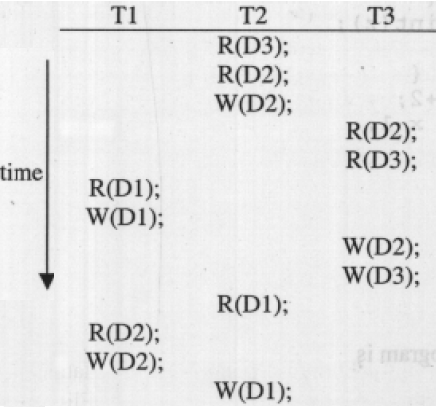GATE-CS-2003
Question 81
A 2 km long broadcast LAN has 107 bps bandwidth and uses CSMA/CD. The signal travels along the wire at 2 × 108 m/s. What is the minimum packet size that can be used on this network?
Question 82
Host A is sending data to host B over a full duplex link. A and B are using the sliding window protocol for flow control. The send and receive window sizes are 5 packets each. Data packets (sent only from A to B) are all 1000 bytes long and the transmission time for such a packet is 50 µs. Acknowledgement packets (sent only from B to A) are very small and require negligible transmission time. The propagation delay over the link is 200 us. What is the maximum achievable throughput in this communication?


Question 83
Consider the following functional dependencies in a database:
Data_of_Birth → Age Age → Eligibility Name → Roll_number Roll_number → Name Course_number → Course_name Course_number → Instructor (Roll_number, Course_number) → GradeThe relation (Roll_number, Name, Date_of_birth, Age) is:
Question 84
Consider the set of relations shown below and the SQL query that follows.
Students: (Roll_number, Name, Date_of_birth) Courses: (Course number, Course_name, Instructor) Grades: (Roll_number, Course_number, Grade)
select distinct Name
from Students, Courses, Grades
where Students. Roll_number = Grades.Roll_number
and Courses.Instructor = Korth
and Courses.Course_number = Grades.Course_number
and Grades.grade = A
Which of the following sets is computed by the above query?
Question 85
Question 86
In the following C program fragment, j, k n and TwoLog_n are integer variables, and A is an array of integers. The variable n is initialized to an integer ≥ 3, and TwoLog_n is initialized to the value of 2*⌈log2(n)⌉
for (k = 3; k < = n; k++)
A[k] = 0;
for (k = 2; k < = TwoLog_n; k++)
for (j = k + 1; j < = n; j++)
A[j] = A[j] || (j % k);
for (j = 3; j < = n; j++)
if (!A[j]) printf(\"%d\", j);
The set of numbers printed by this program fragment is
Question 87
Consider the C program shown below.
#include <stdio.h>
#define print(x) printf(\"%d \", x)
int x;
void Q(int z)
{
z += x;
print(z);
}
void P(int *y)
{
int x = *y + 2;
Q(x);
*y = x - 1;
print(x);
}
main(void)
{
x = 5;
P(&x);
print(x);
}
The output of this program is
Question 88
Consider the function f defined below.
C
For a given linked list p, the function f returns 1 if and only if
struct item
{
int data;
struct item * next;
};
int f(struct item *p)
{
return ((p == NULL) || (p->next == NULL) ||
((P->data <= p->next->data) &&
f(p->next)));
}
Question 89
The cube root of a natural number n is defined as the largest natural number m such that m3 ≤ n. The complexity of computing the cube root of n (n is represented in binary notation) is:
There are 89 questions to complete.
Last Updated :
Take a part in the ongoing discussion
